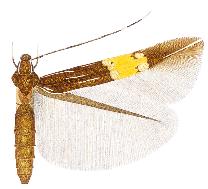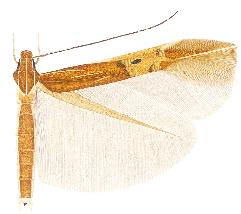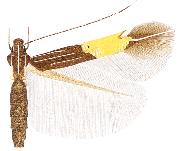
Grammodes stolida, the geometrician, is a moth of the family Erebidae. The species was first described by Johan Christian Fabricius in 1775. It is found in Africa, southern Europe, most of Asia and Australia. It migrates to central and northern Europe as far north as England, Denmark and Finland.
Ypsolopha delicatella is a moth of the family Ypsolophidae. It is known from the United States, including Arizona and California.

Cosmopterix astrapias is a moth of the family Cosmopterigidae. It is known from the United States, Argentina, Costa Rica, Jamaica, Mexico (Tabasco) and Puerto Rico.

Cosmopterix chisosensis is a moth of the family Cosmopterigidae. It is known from Argentina and the United States.

Cosmopterix euporie is a moth of the family Cosmopterigidae. It is known from the Federal District of Brazil.

Cosmopterix fernaldella is a moth of the family Cosmopterigidae. It is known from the United States and Canada.

Cosmopterix langmaidi is a moth of the family Cosmopterigidae. It is known from Belize.

Cosmopterix lespedezae is a moth of the family Cosmopterigidae. It is known from the United States.

Cosmopterix nishidai is a moth of the family Cosmopterigidae. It is known from Costa Rica.

Cosmopterix pulchrimella, the beautiful cosmopterix moth, is a moth of the family Cosmopterigidae. It is known from the United States and Canada. It is also present in the Palearctic realm, where it is known from the Mediterranean Basin, from Portugal to the western Transcaucasus, north to Switzerland and Hungary. It has also been recorded from the Azores, the Canary Islands and Madeira. It has recently been found in southern England.

Cosmopterix scirpicola is a moth of the family Cosmopterigidae. It is known from the United States, where found from Maryland and eastern Wyoming to Florida, south-western Louisiana and California. It has also been recorded from Alabama.

Cosmopterix thelxinoe is a moth of the family Cosmopterigidae. It is known from Brazil and the United States.

Cosmopterix xanthura is a moth of the family Cosmopterigidae. It is known from Mexico (Tabasco). Adults have been recorded in March.

Phalonidia lavana, or Platphalonidia lavana, is a species of moth of the family Tortricidae, the subfamily Tortricinae, and the tribe Cochylini. It has a terrestrial habitat and is found throughout North America. It does not have a Global Conservation Status Rank.
Chionodes xanthophilella is a moth in the family Gelechiidae first described by William Barnes and August Busck in 1920. It is found in North America, where it has been recorded from California, Arizona, Nevada, New Mexico, Texas and North Dakota.
Recurvaria putella is a moth of the family Gelechiidae. It is found in Panama.
Prolita barnesiella is a moth of the family Gelechiidae. It was described by August Busck in 1903. It is found in North America, where it has been recorded from California, Colorado, Arizona, New Mexico, Texas, Wyoming and Utah.
Battaristis bistrigella is a moth of the family Gelechiidae. It was described by August Busck in 1914. It is found in Panama.
Monochroa fragariae, the strawberry crown miner moth, is a moth of the family Gelechiidae. It was described by August Busck in 1919. It is found in North America, where it has been recorded from Oregon and British Columbia.
Taygete sylvicolella is a moth in the family Autostichidae. It was described by August Busck in 1903. It is found in North America, where it has been recorded from Illinois, Maine, New York, Ohio and South Carolina.

